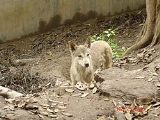
Himalayan Wolf
Encyclopedia
The terms Himalayan wolf and Canis himalayensis have been suggested by several Indian biologists for recognition as a critically endangered
canid species, distinct from Canis lupus. In its morphological features, social and reproductive behavior, the Himalayan wolf resembles the Tibetan wolf
, Canis lupus chanco.
However, the IUCN Wolf Specialist Group has not taken a position regarding this issue. The editors of Mammal Species of the World
consider the small population to be Tibetan wolves a subspecies of the gray wolf
.
 The Himalayan wolf may represent an ancient isolated line of wolves consisting of a small population of about 350 animals. They inhabit an area of 70,000 km2 in the trans-Himalayan region of Himachal Pradesh
The Himalayan wolf may represent an ancient isolated line of wolves consisting of a small population of about 350 animals. They inhabit an area of 70,000 km2 in the trans-Himalayan region of Himachal Pradesh
, Jammu
and Kashmir
in northern India
, and are adapted to the cold environment.
In 2004, a group of 33 Himalayan wolves were spotted in the Spiti Valley
in the northeastern part of Himachal Pradesh
.
, meaning all domesticated dogs are derived from wolves. When the Himalayan lineage was studied, it became apparent these wolves shared no genetic markers with dogs. This indicates the Himalayan wolf played no role in the domestication of dogs. When the divergence of the Himalayan wolf occurred 800,000 years ago, the Himalayan region was going through major geologic and climatic upheaval.
The Indian subcontinent, also home to the Indian wolf
and the gray wolf
, is the only geographical region in the world where these three lineages of wolves exist, thereby supporting the theory that the Indian region is the most likely place of modern wolf evolution.
Mitochondrial DNA
analysis suggests the Himalayan wolf is distinct from the Tibetan wolf
, and represents the most ancient wolf lineage ever recorded.
In April 2009, the Latin binom Canis himalayensis has been proposed as nomenclatural and taxonomic change by the Nomenclature Specialist on the CITES Animals Committee.
in Shiwalik Hills on the lower range of the Himalaya
in West Bengal
, and in the Kufri Zoo with Kufri Himalayan National Park
located in Himachal Pradesh
province.
Critically endangered
Version 2010.3 of the IUCN Red List of Threatened Species identified 3744 Critically Endangered species, subspecies and varieties, stocks and subpopulations.Critically Endangered by kingdom:*1993 Animalia*2 Fungi*1745 Plantae*4 Protista-References:...
canid species, distinct from Canis lupus. In its morphological features, social and reproductive behavior, the Himalayan wolf resembles the Tibetan wolf
Tibetan wolf
The Tibetan wolf , also known as the woolly wolf, is a subspecies of grey wolf native to Central Asia from Turkestan, Tien Shan throughout Tibet to Mongolia, northern China, Shensi, Sichuan, Yunnan, and the western Himalayas in Kashmir from Chitral to Lahul. They also occur in the Korean peninsula...
, Canis lupus chanco.
However, the IUCN Wolf Specialist Group has not taken a position regarding this issue. The editors of Mammal Species of the World
Mammal Species of the World
Mammal Species of the World, now in its 3rd edition, is a standard reference work in zoology giving descriptions and bibliographic data for the known species of mammals.An updated Third Edition of Mammal Species of the World was published late in 2005:...
consider the small population to be Tibetan wolves a subspecies of the gray wolf
Gray Wolf
The gray wolf , also known as the wolf, is the largest extant wild member of the Canidae family...
.
Distribution

Himachal Pradesh
Himachal Pradesh is a state in Northern India. It is spread over , and is bordered by the Indian states of Jammu and Kashmir on the north, Punjab on the west and south-west, Haryana and Uttar Pradesh on the south, Uttarakhand on the south-east and by the Tibet Autonomous Region on the east...
, Jammu
Jammu
Jammu , also known as Duggar, is one of the three administrative divisions within Jammu and Kashmir, the northernmost state in India.Jammu city is the largest city in Jammu and the winter capital of Jammu and Kashmir...
and Kashmir
Kashmir
Kashmir is the northwestern region of the Indian subcontinent. Until the mid-19th century, the term Kashmir geographically denoted only the valley between the Great Himalayas and the Pir Panjal mountain range...
in northern India
India
India , officially the Republic of India , is a country in South Asia. It is the seventh-largest country by geographical area, the second-most populous country with over 1.2 billion people, and the most populous democracy in the world...
, and are adapted to the cold environment.
In 2004, a group of 33 Himalayan wolves were spotted in the Spiti Valley
Spiti Valley
The Spiti Valley is a desert mountain valley located high in the Himalaya mountains in the north-eastern part of the Indian state of Himachal Pradesh. The name "Spiti" means "The Middle Land", i.e. the land between Tibet and India....
in the northeastern part of Himachal Pradesh
Himachal Pradesh
Himachal Pradesh is a state in Northern India. It is spread over , and is bordered by the Indian states of Jammu and Kashmir on the north, Punjab on the west and south-west, Haryana and Uttar Pradesh on the south, Uttarakhand on the south-east and by the Tibet Autonomous Region on the east...
.
Evolution
Until recently, all wolves and dogs were believed to be part of the wolf-dog cladeClade
A clade is a group consisting of a species and all its descendants. In the terms of biological systematics, a clade is a single "branch" on the "tree of life". The idea that such a "natural group" of organisms should be grouped together and given a taxonomic name is central to biological...
, meaning all domesticated dogs are derived from wolves. When the Himalayan lineage was studied, it became apparent these wolves shared no genetic markers with dogs. This indicates the Himalayan wolf played no role in the domestication of dogs. When the divergence of the Himalayan wolf occurred 800,000 years ago, the Himalayan region was going through major geologic and climatic upheaval.
The Indian subcontinent, also home to the Indian wolf
Indian Wolf
Indian wolf and Iranian Wolf are two common names for Canis lupus pallipes, a subspecies of grey wolf which inhabits western India, Pakistan, Iran, Turkey, Saudi Arabia and southern Israel. Some experts have suggested at least some C. lupus pallipes populations be re-classified a canid species...
and the gray wolf
Gray Wolf
The gray wolf , also known as the wolf, is the largest extant wild member of the Canidae family...
, is the only geographical region in the world where these three lineages of wolves exist, thereby supporting the theory that the Indian region is the most likely place of modern wolf evolution.
Mitochondrial DNA
Mitochondrial DNA
Mitochondrial DNA is the DNA located in organelles called mitochondria, structures within eukaryotic cells that convert the chemical energy from food into a form that cells can use, adenosine triphosphate...
analysis suggests the Himalayan wolf is distinct from the Tibetan wolf
Tibetan wolf
The Tibetan wolf , also known as the woolly wolf, is a subspecies of grey wolf native to Central Asia from Turkestan, Tien Shan throughout Tibet to Mongolia, northern China, Shensi, Sichuan, Yunnan, and the western Himalayas in Kashmir from Chitral to Lahul. They also occur in the Korean peninsula...
, and represents the most ancient wolf lineage ever recorded.
Outlook
The future of the Himalayan wolf is uncertain. The systematics of wolves from the Indian subcontinent remains controversial and needs further study.In April 2009, the Latin binom Canis himalayensis has been proposed as nomenclatural and taxonomic change by the Nomenclature Specialist on the CITES Animals Committee.
Captive breeding
In 2000-2001, four of the Zoological Parks of India kept 21 individuals. Eighteen Himalayan wolves are being bred in captivity. They were captured in the wild and are now being preserved in the trans-Himalayan region of India, at the Darjeeling ZooPadmaja Naidu Himalayan Zoological Park
Padmaja Naidu Himalayan Zoological Park is a zoo in the town of Darjeeling in the Indian state of West Bengal. The zoo was opened in 1958, and an average elevation of , is the largest high altitude zoo in India...
in Shiwalik Hills on the lower range of the Himalaya
Himalayas
The Himalaya Range or Himalaya Mountains Sanskrit: Devanagari: हिमालय, literally "abode of snow"), usually called the Himalayas or Himalaya for short, is a mountain range in Asia, separating the Indian subcontinent from the Tibetan Plateau...
in West Bengal
West Bengal
West Bengal is a state in the eastern region of India and is the nation's fourth-most populous. It is also the seventh-most populous sub-national entity in the world, with over 91 million inhabitants. A major agricultural producer, West Bengal is the sixth-largest contributor to India's GDP...
, and in the Kufri Zoo with Kufri Himalayan National Park
Protected areas of Himachal Pradesh
Forests in Himachal Pradesh currently cover an area of nearly , which is about 38.3% of the total land area of the state. The forests were once considered to be the main source of income of the state and most of the original forests were clear felled. The emphasis has shifted, however, from...
located in Himachal Pradesh
Himachal Pradesh
Himachal Pradesh is a state in Northern India. It is spread over , and is bordered by the Indian states of Jammu and Kashmir on the north, Punjab on the west and south-west, Haryana and Uttar Pradesh on the south, Uttarakhand on the south-east and by the Tibet Autonomous Region on the east...
province.
See also
- Indian wolfIndian WolfIndian wolf and Iranian Wolf are two common names for Canis lupus pallipes, a subspecies of grey wolf which inhabits western India, Pakistan, Iran, Turkey, Saudi Arabia and southern Israel. Some experts have suggested at least some C. lupus pallipes populations be re-classified a canid species...
- Eastern Canadian wolf
- Gray wolfGray WolfThe gray wolf , also known as the wolf, is the largest extant wild member of the Canidae family...

